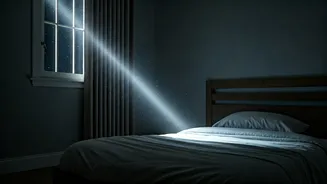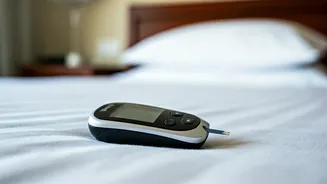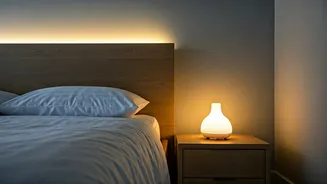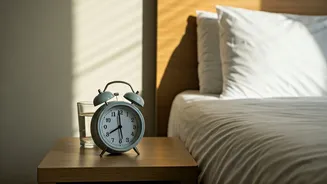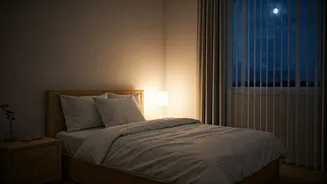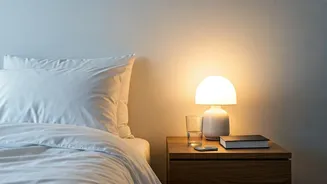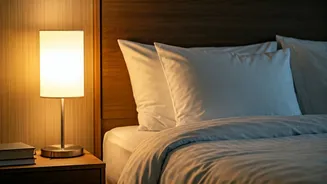The Midnight Menace
The silent yet potent impact of light exposure during sleep is gradually coming to light as a crucial health factor. Numerous studies have pinpointed nighttime
light, especially from artificial sources, as a major contributor to global health issues. The human body's intricate internal clock, also known as the circadian rhythm, is critically sensitive to light. Exposure to light at night throws off this natural rhythm, which regulates sleep, hormone release, and various other essential biological processes. Artificial light from sources like streetlights, electronic devices, and even bedside lamps can interfere with the production of melatonin, a hormone vital for sleep regulation. This disruption can then lead to a cascade of health problems.
Circadian Rhythm's Role
Our internal body clock, the circadian rhythm, orchestrates a symphony of bodily functions over roughly a 24-hour cycle. This internal clock is intrinsically linked to the environment, particularly light and dark cycles. The circadian rhythm affects not only sleep-wake patterns but also metabolic processes, immune function, and mental well-being. Exposure to light at night is like throwing a wrench into the gears of this delicate system. This disruption can manifest in various ways, from sleep disturbances and fatigue to a heightened risk of chronic diseases. Consistent misalignment of the circadian rhythm has been associated with an increased susceptibility to conditions like obesity, type 2 diabetes, cardiovascular disease, and certain types of cancer. It underscores the profound importance of protecting our sleep environment from artificial light.
Light's Melatonin Interference
The melatonin hormone, primarily produced by the pineal gland in the brain, is crucial for regulating the sleep-wake cycle. Its release is tightly controlled by the presence or absence of light. In the presence of darkness, the body produces melatonin, signaling to the body that it's time for sleep. Conversely, light inhibits melatonin production, keeping us awake and alert. When exposed to artificial light at night, the body mistakes the light for daylight, suppressing melatonin production. This can lead to sleep disturbances, as the body struggles to transition into a state of rest. Furthermore, prolonged suppression of melatonin has been linked to a range of health issues. Melatonin acts as an antioxidant and plays a role in immune function, so its deficiency can potentially contribute to inflammation, compromised immunity, and increased risks of certain diseases.
Health Risks Unveiled
The cumulative effects of disrupted sleep and altered circadian rhythms resulting from nighttime light exposure are far-reaching. Studies have indicated a direct correlation between light exposure at night and a higher incidence of various health problems. These include obesity, due to the metabolic disturbances linked to sleep deprivation; type 2 diabetes, a result of impaired glucose metabolism; and cardiovascular diseases, stemming from chronic stress and inflammation. Furthermore, some research suggests a link between light exposure and an increased risk of certain cancers, such as breast and prostate cancer. The precise mechanisms behind these links are still under investigation, but it's increasingly clear that the seemingly benign habit of leaving the lights on at night could be detrimental to long-term health.
Creating a Dark Oasis
Fortunately, mitigating the negative impacts of nighttime light exposure is within reach. Simple lifestyle adjustments can significantly improve sleep quality and reduce health risks. The most fundamental step is to create a dark sleep environment. This means eliminating or minimizing light sources in the bedroom. Blackout curtains are a great way to block out any external light, whether from streetlights or the rising sun. Dimming or turning off electronic devices, such as phones and tablets, before bed is also crucial. These devices emit blue light, which is particularly disruptive to melatonin production. Avoiding bright lights at least an hour before bedtime will help signal the body it's time to sleep. Moreover, using a low-wattage, warm-toned nightlight can provide a sense of comfort while minimizing disruption.
Beyond the Bedroom
While creating a dark sleep environment is essential, the scope of addressing this issue extends beyond the bedroom. Urban planning and lighting policies can also play a role in promoting better health. Cities and towns can implement measures to reduce light pollution, such as using shielded streetlights and directing light downward. This reduces the amount of light that escapes into the night sky, which benefits not only human health but also the environment. Personal choices, like opting for warmer-toned lighting in the evenings and making use of smart home technologies to dim lights automatically, can help support these efforts. Moreover, raising awareness about the health risks associated with nighttime light exposure is key, empowering individuals to take proactive steps to improve their sleep and overall well-being.
